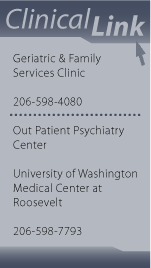Elderly Learn Ways to Fight Depression
Homebound elderly persons lacking social interaction may be more likely to face symptoms of depression. Generally, these symptoms may go untreated for several reasons. One reason may be physical impairment. With limited mobility, it is difficult to get to a clinic to get proper treatment. The belief that depression is normal at their age because older individuals have lost friends and functionality may be another reason. Denial may also account for why some seniors are not seeking help for depression.
"They generally don't like to admit they're depressed," said Dr. Paul Ciechanowski, assistant professor of psychiatry and behavioral sciences. "There's a stigma about depression in general and more so among older people. Thus they might be more reluctant to talk to friends, family, and health care providers about feeling depressed."
Realizing that seniors have limited mobility or are reluctant to seek help for depression, the UW Health Promotion Research Center conducted its first community-based in-home study. The researchers were Ciechanowski, Dr. Edward Wagner, Dr. James Logerfo and others . The Centers for Disease Control and Prevention funded the project. In the study, 138 patients more than 60 years old with minor depression or dythymia (chronic depression) were randomly put into two different groups.
One group received treatment through the Program to Encourage Active, Rewarding Lives for Seniors (PEARLS). This program offers six to eight one-hour, in-home sessions from a social worker employed by community agency collaborators. The first of four components of the PEARLS program is problem-solving therapy, a type of psychotherapy, where the social worker and patient work together to break down accumulated problems that have become overwhelming. This shows the patient they do have the capacity to deal with these problems.
The second component, physical activation, involves assessing patients' capacity to engage in physical activity, and helping them tailor a physical activity program that optimally involves interaction with others. The third component is social activation. This may involve physical activities or taking trips to day centers for bingo or arts and crafts to help individuals reconnect with others. The last component is pleasant events scheduling where patients take time out to enjoy themselves. Each is given a list of 250 activities to choose from.
Advice about antidepressant use from the PEARLS intervention team was also available to primary-care providers of a few of the study patients. After the in-home visits, the social workers made follow-up phone calls once a month to check on the patient. The second group received usual care, meaning they did not receive additional services but were allowed to seek treatment for depression at their own discretion.
The PEARLS program proved highly effective. It significantly reduced depressive symptoms and improved health status in chronically medically ill older adults with minor depression or dysthymia. After 12 months, PEARLS participants were three times more likely as non-participants to have remission from depression.
"One of the main reasons PEARLS worked so well is because it was an in-home treatment. If it wasn't in-home it wouldn't happen," Ciechanowski said. "It's essentially a systemized way of doing a house call. These individuals, who were home-bound with a mean of five chronic medical conditions benefited from these house calls since they may not otherwise engage in psychotherapy if they had to leave their home."
The study was published in the April 7, 2004 edition of the Journal of the American Medical Association.
